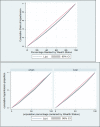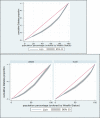Socioeconomic inequalities in the risk factors of noncommunicable diseases (hypertension and diabetes) among Bangladeshi population: Evidence based on population level data analysis
- PMID: 36126087
- PMCID: PMC9488802
- DOI: 10.1371/journal.pone.0274978
Socioeconomic inequalities in the risk factors of noncommunicable diseases (hypertension and diabetes) among Bangladeshi population: Evidence based on population level data analysis
Abstract
Background: Noncommunicable diseases (NCDs) such as hypertension and diabetes are among the most fatal disease and prevalent among the adult population worldwide, including Bangladesh, and pose a public health threat. Understanding the socioeconomic inequalities linked to NCD risk factors can aid in the development of effective strategies to reduce the disease's recurrence. However, the literature on socioeconomic inequalities in hypertension and diabetes prevalence in Bangladesh is scant. Therefore, this study seeks to assess the inequality in hypertension and diabetes prevalence and to identify factors that may contribute to socioeconomic inequalities in Bangladesh.
Methods: The current study incorporated data from a recent round of Bangladesh Demographic and Health Survey (BDHS 2017-18). The age-standardized prevalence rates of hypertension and diabetes were reported, and the log-binomial regression technique was used to identify the relevant confounders. Additionally, socioeconomic inequalities were quantified using a regression-based decomposition technique in which the concentration index (CIX) and Concentration curve were produced to determine the socioeconomic factors contributing to inequality.
Results: Hypertension and diabetes were shown to have an age-standardized prevalence of (11.29% 95% CI: 11.13-11.69) and (36.98% 95% CI: 36.79-37.16), respectively. Both hypertension and diabetes were shown to be pointedly linked to the respondents' age, wealth status, being overweight or obese, and a variety of respondents' administrative divisions (p <0.001). In Bangladesh, household wealth status accounted for approximately 25.71% and 43.41% of total inequality in hypertension and diabetes, respectively. While BMI played a significant role in the emergence of inequality, the corresponding percentages for diabetes and hypertension are 4.95 and 83.38, respectively. In addition, urban areas contributed 4.56% inequality to increase diabetes among Bangladeshi inhabitants while administrative region contributed 4.76% of the inequality of hypertension.
Conclusion: A large proportion of Bangladesh's adult population suffers from hypertension and diabetes. It is critical to recognize the value of equity-based initiatives in order to optimize the benefit-risk ratio and cost effectiveness of preventive health programmes. Integrating equity considerations into interventions is critical for policies and programmes to achieve their objectives. As a result, these findings can be taken into account when making existing and prospective policy decisions, as well as following its progression with economic development of Bangladesh.
Conflict of interest statement
The authors have declared that no competing interests exist.
Figures
Similar articles
-
Socio-economic inequalities in diabetes and prediabetes among Bangladeshi adults.Diabetol Int. 2021 Oct 25;13(2):421-435. doi: 10.1007/s13340-021-00556-9. eCollection 2022 Apr. Diabetol Int. 2021. PMID: 35463862 Free PMC article.
-
Socio-Economic Inequality of Chronic Non-Communicable Diseases in Bangladesh.PLoS One. 2016 Nov 30;11(11):e0167140. doi: 10.1371/journal.pone.0167140. eCollection 2016. PLoS One. 2016. PMID: 27902760 Free PMC article.
-
Socioeconomic inequalities in hypertension in Kenya: a decomposition analysis of 2015 Kenya STEPwise survey on non-communicable diseases risk factors.Int J Equity Health. 2020 Dec 2;19(1):213. doi: 10.1186/s12939-020-01321-1. Int J Equity Health. 2020. PMID: 33267846 Free PMC article.
-
Tobacco Control Measures to Reduce Socioeconomic Inequality in Smoking: The Necessity, Time-Course Perspective, and Future Implications.J Epidemiol. 2018 Apr 5;28(4):170-175. doi: 10.2188/jea.JE20160206. Epub 2017 Nov 18. J Epidemiol. 2018. PMID: 29151476 Free PMC article. Review.
-
Summary Measures of Health Inequality: A Review of Existing Measures and Their Application.Int J Environ Res Public Health. 2022 Mar 20;19(6):3697. doi: 10.3390/ijerph19063697. Int J Environ Res Public Health. 2022. PMID: 35329383 Free PMC article. Review.
Cited by
-
Bayesian analysis of non-communicable diseases risk factors: a focus on the lower-educated population in Bangladesh.Int Health. 2025 Jul 1;17(4):499-508. doi: 10.1093/inthealth/ihae087. Int Health. 2025. PMID: 39657720 Free PMC article.
-
Effect of Physical Activity and Dietary Changes on Management of Type 2 Diabetes Mellitus Patients: A Case-Control Study in Bangladesh.Endocrinol Diabetes Metab. 2025 May;8(3):e70051. doi: 10.1002/edm2.70051. Endocrinol Diabetes Metab. 2025. PMID: 40372910 Free PMC article.
-
Socioeconomic inequalities in type 2 diabetes mellitus: a study based on a population-based survey in Iran.BMC Public Health. 2024 Mar 30;24(1):926. doi: 10.1186/s12889-024-18452-7. BMC Public Health. 2024. PMID: 38555434 Free PMC article.
-
Early Prediction of Diabetes Using an Ensemble of Machine Learning Models.Int J Environ Res Public Health. 2022 Sep 28;19(19):12378. doi: 10.3390/ijerph191912378. Int J Environ Res Public Health. 2022. PMID: 36231678 Free PMC article.
-
Religious minority status and risk of hypertension in women: Evidence from Bangladesh.Heliyon. 2024 Jun 22;10(13):e33428. doi: 10.1016/j.heliyon.2024.e33428. eCollection 2024 Jul 15. Heliyon. 2024. PMID: 39035524 Free PMC article.
References
-
- Niessen LW, Mohan D, Akuoku JK, Mirelman AJ, Ahmed S, Koehlmoos TP, et al.. Tackling socioeconomic inequalities and non-communicable diseases in low-income and middle-income countries under the Sustainable Development agenda. Lancet. 2018;391: 2036–2046. doi: 10.1016/S0140-6736(18)30482-3 - DOI - PubMed
-
- Rahman M, A., Halder HR, Kundu S, Sultana F, Mohammed S, Islam S. Trends in the prevalence and associated factors of prediabetes and diabetes in Bangladesh: Evidence from population-based cross-sectional surveys. 2022. - PubMed
-
- Rahman MA, Parvez M, Halder HR, Yadav UN, Mistry SK. Prevalence of and factors associated with prehypertension and hypertension among Bangladeshi young adults: An analysis of the Bangladesh Demographic and Health Survey 2017–18. Clin Epidemiol Glob Heal. 2021;12: 100912. doi: 10.1016/j.cegh.2021.100912 - DOI
MeSH terms
LinkOut - more resources
Full Text Sources
Medical
Research Materials




